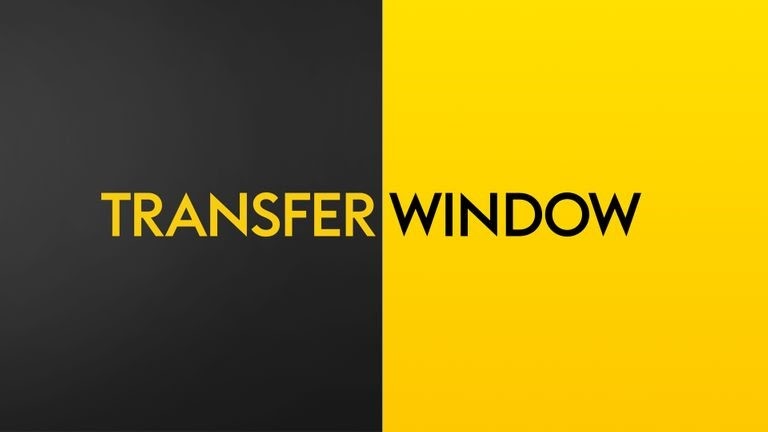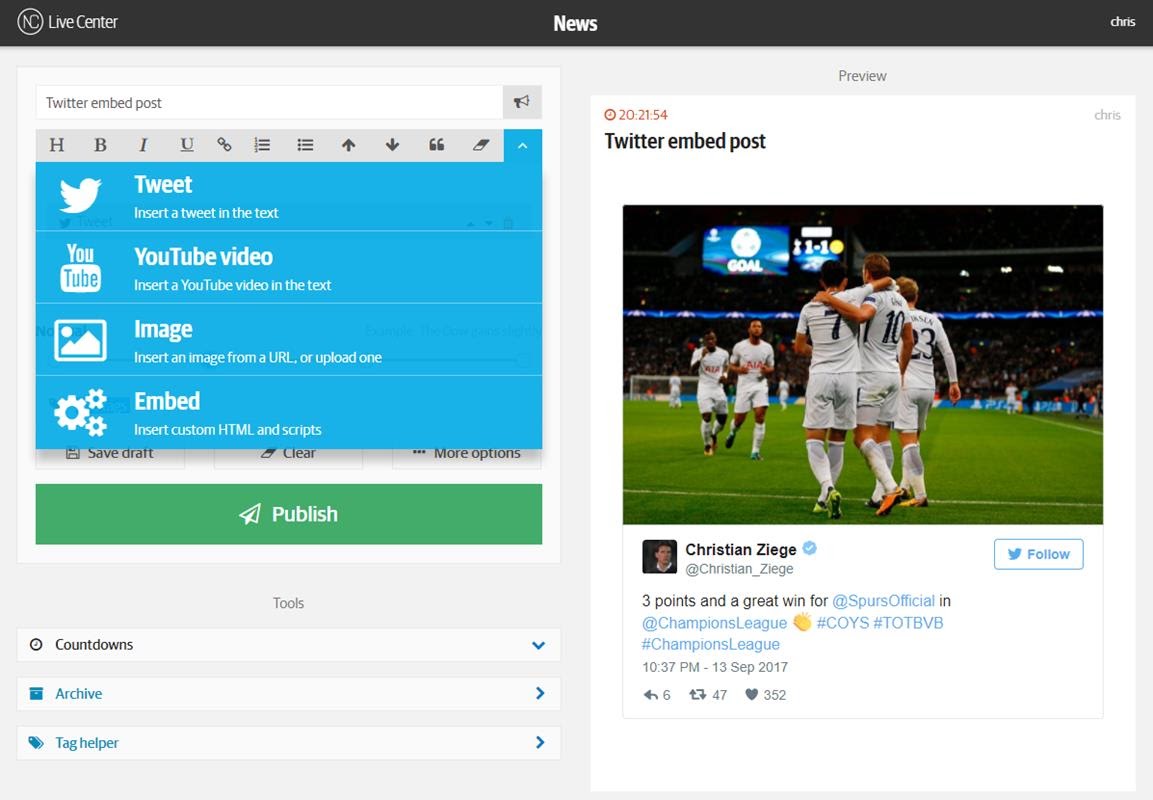How to cover the football transfer window with Live Blogging

This post is also available in:
English
Live Blogging the Football Transfer Window
The Silly Season which are followed closely by millions are those few times during the year when football players can go from one club to another and as the world of football today is competitively on parity on so many levels, football clubs seek to obtain anything that gives them an advantage. Towards this end transfers are one of the most important aspects (if not the most important) that ends up making the difference for teams at the top of leagues.
Because they are so important for clubs: in many cases setting the prospect for the season, the windows are a virtual petri dish for rumors and gossip to flourish. Long before facts are known, coaches and managers have made statements, fast changing gossip and analysis from experts move transfer news topics. Fans are aware of this and are constantly seeking trustworthy and active sources of news and gossip – providing sports sites, fan sites, and news outlets with an opportunity to grow their traffic of these engaged and dedicated readers.
Important things to know
Before we dive into why live coverages of the Silly Season are so popular, let’s explore the rules and background for the transfer window, important dates to be aware of, and some high-profile transfers from years past.
What is the Football Transfer Windows?
Football transfers are the movements through which football players go from one club with which they have a current contract with to another one, normally with the payment of a certain amount of money agreed between both clubs for the termination of the current football contract player or the payment of a release clause in case the contract has it–this amount of money is called transfer fee.
If a player has no contract with a club or is in the last 6 months of his current contract, he is completely free to negotiate with the club of his choice without the authorization of his current club or the last club he played for. This is part of FIFA regulations and is met in the vast majority of countries in the world except in isolated cases such as Mexico, for example. Another way for a player to change from one club to another is through the loan format where the football player can go to another club with a current contract with his previous club for a pre-established period and sometimes has loans and others do not. This is a widely used method to give regularity of play to young players or those who are not expected to have continuity in the current first team.
History of transfers
Since the professionalization of football back in 1885, there has been a system of football players transfers that has simply evolved over the years until reaching the system that we currently have. The most important moment in the history of football transfer is, without a doubt, the Bosman ruling, named after former footballer Jean-Marc Bosman, who was a Belgian midfielder who played for his country’s RFC Liege in 1990 and had an offer from France’s USL Dunkerque that he decided to accept however the Liege wanted financial compensation that the French club was unwilling to pay All this considering that Bosman had terminated his contract with the club of his native country. The player made a lawsuit that ended up marking a before and an after in football since the resolution of the case showed that a player without a contract can freely negotiate with another club without paying any previous club. Additionally, football players from member countries of the European Union were granted to be considered nationals, that is, they ceased to occupy a place in the quotas of foreigners and this has resulted in European clubs with a high number of nationalities.
Thanks to the Bosman ruling, there have been very important transfers in the world of football, such as Robert Lewandowski who went from Borussia Dortmund to the rival, Bayern Munich in 2014, Andrea Pirlo from AC Milan to Juventus in 2011 or Sol Campbell from Tottenham to city rival Arsenal FC.
These are examples of signings that would not have been possible had it not been for the Bosman ruling as it would have required direct negotiation between rival teams by one of its star players, which is usually, to say the least, complicated. Thanks to this ruling, we today have more established frameworks for transfers that both offers more freedom for players, and a more dynamic sport for fans and clubs.
Important Dates
The international football confederations, in conjunction with FIFA, have defined periods of the year where transfers of football players can occur, which is known as the transfer window.
In most European countries, the period from July 1 to August 31 is called the Summer Transfer Window, while the period from January 1 to January 31 is known as the Winter Transfer Window. There are cases like the one in England where the summer transfer window closes when the league championship begins, that is, in the middle of the month of August, however, being open in other countries, players can go to other clubs outside of England but new players may not join the English teams. During these periods (summer and winter transfer windows), the registration of new players by the different national football federations is allowed.
Outside of Europe, we also find different transfer windows, as in the case of South America, where the winter transfer window period usually extends until the beginning of the championships, which is usually in February, and the MLS also has a different period than the European calendar, for example.
High-profile transfers throughout the years
Due to the growth at the marketing level and worldwide popularity of football, the payments made between clubs by transfer fee are getting higher, leaving the 100 pounds paid by Aston Villa to West Bromwich Albion in 1893 very far.
Next, we present the list of the most expensive signings in the history of world football, clarifying that these figures are based on transfer fees only without considering the clauses of the contracts:
Neymar (From FC Barcelona to Paris Saint Germain – 2017): The French club paid the release clause that the Brazilian attacker had stipulated in his contract with FC Barcelona that reached 198 million pounds.
Kylian Mbappé (From AS Monaco to Paris Saint Germain – 2018): It is the most expensive signing between two clubs from the same country in football history, reaching 116 million pounds. In this case, a loan modality was used with a compulsory purchase option for Paris Saint Germain, so in his first season as a player for the Parisian club, Mbappé was on loan.
Joao Felix (From SL Benfica to Atletico de Madrid – 2019): After his very good season with Benfica, the young Portuguese was signed by the Spanish club for 114 million pounds.
The rest of the top 10 most expensive signings in football history are completed:
Antoine Griezmann (From Atletico de Madrid to FC Barcelona – 2019) for 107 million pounds.
Phillipe Coutinho (From Liverpool FC to FC Barcelona – 2018) for 105 million pounds.
Ousmane Dembélé (From Borussia Dortmund to FC Barcelona – 2017) for 97 million pounds.
Paul Pogba (From Juventus to Manchester United– 2016) for 89 million pounds.
Eden Hazard (From Chelsea to Real Madrid – 2019) for 89 million pounds.
Cristiano Ronaldo (From Real Madrid to Juventus – 2018) for 88 million pounds.
Gareth Bale (From Tottenham to Real Madrid – 2013) for 86 million pounds.
Why Live Blogs are widely used in covering the transfer windows
The transfer windows give rise to a lot of follow-up by the press due to the interest aroused in the fans to know who the next signing of their club or which player may not continue next season. The hobbyist usually pays a lot of attention to that type of news that usually exists throughout the year but that during transfer windows is much more recurrent and constant, leading to even talk of rumors, gossip or even fake news of transfers that have no real basis.
With so much uncertainty and news moving so fast, how do fans stay on top of transfer news? Of the many ways to consume breaking news, and get access to the latest rumors, live blogs are one of the most suitable ways of engaging readers and sharing the latest news.
Creating a curated feed of latest news, pulling in social media, embedding videos, and linking to full-length articles, live blogging allows you to create a location for content from across the world and publish this to readers quickly and easily. Done over time, and with enough content to constantly provide new pieces of information, readers establish habits of revisiting the live blog again and again.
How to further engage with readers – Nettavisen.no’s Silly Season Live Blog
The most successful live blogs also provide an additional benefit to readers – it allows them to submit comments and ask questions. Nettavisen.no recently launched a new Transfer Window Live Blog that supports just this. In a separate tab in the same live blog, their journalists and experts publish comments from readers and answer questions.
In addition, the live blog has some unique features which also helped them generate new advertisements revenue and convert readers to registered users. For example:
- In one live blog, readers can quickly sort the feed in 3 different tabs of content:
1. Main feed containing all news and rumors
2. News feed dedicated to only confirmed news, and:
3. Q&A with journalists where comments and questions are published along with answers
- All posts are tagged with team names and player names which readers can click to see only posts related to the specific team or player
- Readers are required to log in in order to comment which has proven a great way to get users to register on their site
- Ads are natively integrated into the feed at certain intervals, which is a great monetization feature
- A completely customized design is applied to make the live blog fit Nettavisen’s brand
With their new live coverage, Nettavisen has seen higher traffic, generated more advertising revenue, and increased engagement with their sports readers. They are already planning how to include insights from this live blog to their other live coverages across their site.
Impact of Corona on the Transfer Windows
At the present time, with football competitions in almost all the world without activity due to the COVID-19 situation, there are many rumors about transfers of football players due to the lack of news related to other sports issues and despite not being one of the transfer window. In fact, there is uncertainty about the near future of football, since today there is no official information on when local and international competitions are going to be restored, if it is decided to continue or when and how it will open the next transfer window.
The only thing that is known so far is that FIFA has requested that the contracts of the football world that end on June 30 of this year be continued, this in order to guarantee the work to those who work in the clubs football in these difficult periods.
In addition to the request by FIFA, there are an infinity of rumors and contrasted information, not only related to the transfers of football players but also to the future of football, the current day to day of football players and how they carry the quarantine, the measures that each club and confederation is taking among other things.
Try out Transfer Window live blogging
If you are interested in growing your traffic, increasing engagement with readers, and growing your advertising revenue, Live Center is the ideal solution. Get up and running in minutes and start creating a Silly Season live blog right away!



